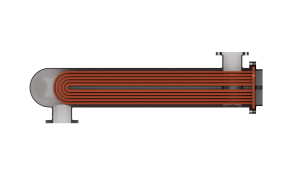Specific Dissipation Heat Exchanger (G-G)
Heat exchanger parameterized by specific dissipation data for systems with two gas flows
Since R2024a
Libraries:
Simscape /
Fluids /
Heat Exchangers /
Gas
Description
The Specific Dissipation Heat Exchanger (G-G) block models a gas-gas heat exchanger. The fluids are single phase and each a gas. Neither fluid can switch phase and so, as latent heat is never released, the exchange is strictly one of sensible heat.

Heat Transfer Model
The block heat transfer model depends on the concept of specific dissipation, a measure of the heat transfer rate observed when gas 1 and gas 2 inlet temperatures differ by one degree. Its product with the inlet temperature difference gives the expected heat transfer rate:
where ξ is specific dissipation and
TIn is inlet temperature for gas 1 (subscript
1) or gas 2 (subscript 2). The specific dissipation
is a tabulated function of the mass flow rates into the exchanger through the gas 1 and gas
2 inlets:
To accommodate reverse flows, the tabulated data can extend over positive and negative flow rates, in which case the inlets can also be thought of as outlets.
The specific dissipation is the heat exchanger heat transfer rate divided by the difference in inlet temperatures
The specific dissipation is also equal to the overall heat transfer coefficient defined based on inlet temperature multiplied by the heat transfer surface area or the heat capacity rate multiplied by the effectiveness factor, for whichever fluid has a smaller value.
The heat transfer model, as it relies almost entirely on tabulated data, and as that data normally derives from experiment, requires little detail about the exchanger. Flow arrangement, mixing condition, and number of shell or tube passes, if relevant to the heat exchanger modeled, are assumed to manifest entirely in the tabulated data.
The fluid properties that the block uses in heat transfer calculations are the average between the value at the inlet and the value in the fluid volume.
See the Specific Dissipation Heat Transfer block for more detail on the heat transfer calculations.
Composite Structure
The block is a composite component. A Specific Dissipation Heat Exchanger Interface (G) block models the gas flow on side 1 of the heat exchanger. Another models the gas flow on side 2. A Specific Dissipation Heat Transfer block captures the heat exchanged across the wall between the flows.

